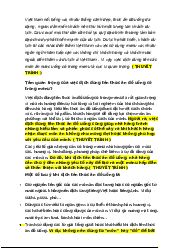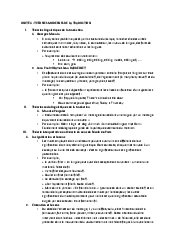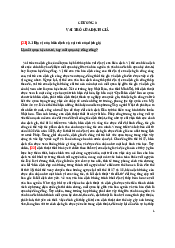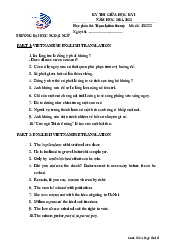




Preview text:
1.Defining translation:
- Translation is the replacement of textual material in one language (source language) by
equivalent textual material in another language (target language). (J.C. Catford, 1965)
- Translation is the process of conveying messages across
linguistic and cultural barriers. (Ian Tudor)
- Translation is rendering the meaning of a text into another language in the way that the
author intended the text. (Peter Newmark, 1988)
- Translation consists of reproducing in the receptor language the closest natural
equivalence of the source language message, first in terms of meaning and secondly in
terms of style. (Nida E Taber, 1982)
- Translation is a process of finding a target language equivalent for a source language utterance. (Pinchuck, 1977)
2.Interlingual, Intralingual and Intersemiotic Translation:
- Intralingual translation (dịch nội ngữ) – translation within the same
language, which can involve rewording or paraphrase
- Interlingual translation (dịch liên ngữ) – translation from one language to another
- Intersemiotic translation (liên kí hiệu học) – translation of the verbal
sign by a non-verbal sing, e.g., music or image, or braille (chữ nổi)
3.A prerequisite for study in translation and interpretation: - General knowledge. - Cultural knowledge.
- Specific translative/ interpretive skills.
4.Requirements for doing well in translation and interpretation:
-“A good translator/ interpreter has to be a vertable mine of information no matter what subject he is dealing with”
“Besides, vocabulary iss not enough – In order to make any sense out of the text or a
speech, you have to understand what the author is really saying”
-Translation and interpretation involve ideas, not words.
5.Definition of Translation versus Interpretation:
- Translation implies carefully analyzing the message given within the
context of a perticular linguistic code and transferring this message
into another written linguistic code.
- Interpretation, on the other hand, means doing the same but orally and simultaneously.
6.Four basic types of translation and interpretation:
Prepared translation (biên dịch có c.bị trước): involves the preparation of a translation
outside the class and it is then constructively critized by both students and teacher.
Sight translation (dịch có nhiều tài liệu): includes an immediate, oral rendition based on a written text.
Consecutive interpretation (phiên dịch nối tiếp – dịch đuổi): is a process of listening to
a speech of lecture one languge and at a certain moment, transcribing and summarixing
it orral, in another languge. The time lapse between the speech and your interpretation varies.
Simultaneous interpretation (phiên dịch đồng thời/song song – dịch cabin): involves
the immediate, simultaneous interpretation of what being said into another languge.
7.Specific subskills required for doing consecutive interpretation:
1.Learning to repeat what a speaker has said, first is one’s dominant language;
2.Memory training, e.g. practice in increasing retention of clusters of words and numbers;
3.Learning to take accurate notes; 4.Learning to summarize; 5.Learning to simplify; 6.Learning to paraphrase; 7.Learning to clarify;
8.Learning to express with confidence and naturalness.
8.The notion “context” in translation: Context is that which occurs before and/or after a
word, a phrase or even a long utterance or text
9.Four types of texts identified by Peter Newmark:
1.Narrative: a dynamic sequence of events with emphasis on verbs, verb nouns or phrasal verbs.
2.Description: static, with emphasis on linking verbs, adjectives, adjectival nouns.
3.Discussion: a treatment of ideas, with emphasis on abstract nouns (concepts), verbs of
thought, mental activity (consider, argue, etc.), logical argument and connectives.
4.Dialogue: with emphasis on colloquialisms and phaticisms.
10. Six principles of translation:
a) Meaning: The translation should reflect accurately the meaning of original text.
Nothing should be arbitrarily added or removed.
b) Form: The ordering of words and ideas in the translation should match the originals closely as possible.
c) Register: Languages often differ greatly in their levels of formalily in a given context
(say, the business letter). To resolve these differences, the translator must distinguish
between formave and fixed expressions and personal expressions, in which the writer or speaker sets the tone.
d) Source language influence: One of the most frequent criticisms of translation is that
"it doesn't sound natural". This is because the translator's thoughts and choises of words
are too strongly molded I by the original text. A good way of shaking off the SL
influence is to set the text aside and translate a few sentences aloud, from memory. This
will suggest natural patte patterns of thought in the Le, which may not come to mind
when the exe is fixed on the SL text.
e) Style and clarity: The translator should not change the style of the original
f) Idiom: Idiomatic expressions are notoriously untranslatable. These include similes,
metaphors, proverbs, and sayings (as good as gold), jargon, slang, and colloquialisms,
and phrasal verbs. If the idiom cannot be translated directly, try any of the following:
1, Retain the original word, in, in inverted commas
2, Retain the priginal expression, with a literak explanation in brackets 3, Use a close equivalent.
4, Use a non- idiomatic or plain prose translation
If the idiom does not work in the L1, do not force it into the translation.
Vd: No pain no gain: k có áp lực k có kim cương//Seeing is believing Tai nghe k bằng
mắt thấy//Love is blind: tình yêu mù quáng//Out of right, out of mind: xa mặt cách lòng
11. The notions “language” and “culture”. Explain why translation and culture are intimately connected:
Language is a set of verbal symbols that are primarily auditory, but secondarily written.
Language also constitutes the most distinctive feature of a culture, which may be
described in a simplistic manner as the totality of the beliefs and practices of a society.
-Competent translators are always aware that ultimately words only have
meaning in terms of the corresponding culture
-A phrase that appears easy to translate may actually contain cultural subtleties that,
unless they are accounted for, can bring just the opposite meaning than is intended.
Translation without deep cultural context can be dangerous, especially when meanings are critical.
12. Connotative meaning and denotative meaning. Give examples for illustration:
Connotative meanings refer to the additional meanings that a word or phrase has beyond
its central meaning ( =denotative meaning).
A translator must be aware of the positive and negative connotation of words in the
source language so as to translate with an appropriate connotation in the target language. Vd: run suggest haste Sofa------comfort Tropic ----heat
14. Four types of translational equivalence:
(1) Linguistic equivalence, where there is homogeneity on the linguistic level of both
SL and TL, i.e. word for word translation.
(2) Paradigmatic equivalence, where there is equivalence of “the elements of a
paradigmatic expressive axis”, i.e. elements of grammar, which Popovic sees as being
a higher category than lexical equivalence.
(3) Stylistic (translational) equivalence, where ther is “functional equivalence of
elements in both original and translation aiming at an expressive identity with an
invariant of identical meaning.”
(4) Textual (syntagmatic) equivalence, where there is equivalence of form and shape.
13. Two types of untranslatability: - Linguistic untranslatability is due to differences
in the SL and the TL, whereas, cultural untranslatability is due to the absence in
the TL culture of a relevant situational feature for the SL text.
14. Loss and gain in translation: - Loss: The disappearance of certain features in the TL
text which are presented in the SL text.
- Gain: The enrichment or clarification of the source language text in the process of translation.
15. Translation methods:
1. Word for word translation: (dịch từng từ): Demonstrated as interlinear translation
The TL immediately below the SL words SL word-order is preserved, the words are
commonly translated singly out of context. Used as a pre-translation process to
understand the mechanics of sl text.
2. Literal translation (dịch sát nghĩa): SL grammatical constructions are converted
nearest TV equivalents, but the lexical words are still translated singly, out of context.
As a pre-translation process, this indicates s 1 the problems to be solved.
3. Faithful translation: (dịch nguyên văn): Attempts to reproduce the precise
contextual meaning of the original within the constraints of the TL grammatical
structures. It "transfers" cultural words and preserves the degree of granimatical and
lexical "abnormality". "abnormality". Translation of this type attempts to be completely
faithhel to the intention of SL writer
4. Semantic translation: The distinction between "faithful" and "semantic" translation -
s that the first uncompromising and dogmatic, while the second is more flexible.
5. Adaptation (phỏng dich): This is the 'freest' form of translation. It is used mainly for
plays (comedies) and poetry: the themes, characters, plots are usually preserved, the SL
culture converted to the TL culture and the text rewritten by an established dramatist or poet.
6. Free translation (dịch tự do): Reproduces the matter without the manner, or the
conten without the form of the original. Usually, it is a paraphrase much longer than the
original, a so-called 'intralingual translation', not a real translation at all
7. Idiomatic translation (dịch thành ngữ): Idiomatic translation reproduces the 'message'
of the original but tends distort nuances of meaning by preferring colloquialisms and
idioms whe these do not exist in the original.
8. Communicative translation: Communicative translation to render the exact of the
original in such a way that both content and language are readily and to the relationship.
16. Sematic translation and communicative translation: Communicative translation
attempts to produce on its readers an effect as close as possible to that obtained on the
readers of the original. Semantic translation attempts to render as closely as possible the
semantic and syntactic structures of the second language allow the exact contextual meaning of the original.



